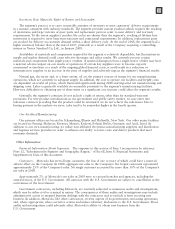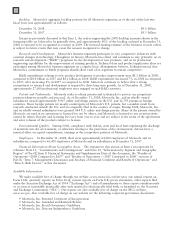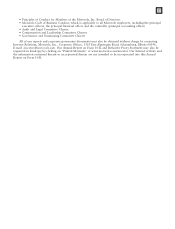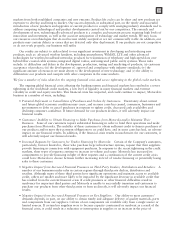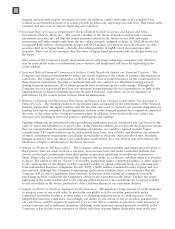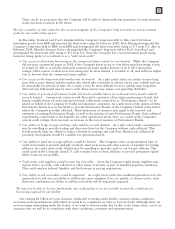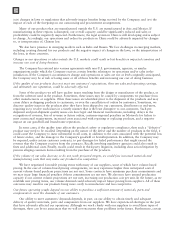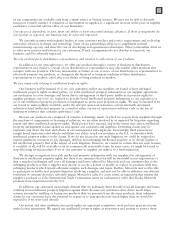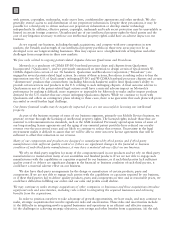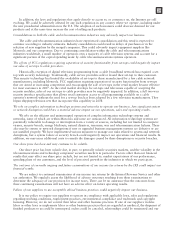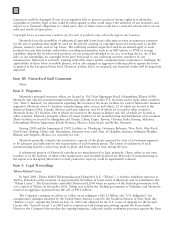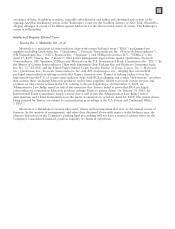Motorola 2008 Annual Report Download - page 32
Download and view the complete annual report
Please find page 32 of the 2008 Motorola annual report below. You can navigate through the pages in the report by either clicking on the pages listed below, or by using the keyword search tool below to find specific information within the annual report.
(xiv) changes in laws or regulations that adversely impact benefits being received by the Company; and (xv) the
impact of each of the foregoing on our outsourcing and procurement arrangements.
Many of our products that are manufactured outside the U.S. are manufactured in Asia and Mexico. If
manufacturing in these regions is disrupted, our overall capacity could be significantly reduced and sales or
profitability could be negatively impacted. Furthermore, the legal system in China is still developing and is subject
to change. Accordingly, our operations and orders for products in China could be adversely impacted by changes
to, or interpretation of, Chinese law.
We also have presence in emerging markets such as India and Russia. We face challenges in emerging markets,
including creating demand for our products and the negative impact of changes in the laws, or the interpretation of
the laws, in those countries.
Changes in our operations or sales outside the U.S. markets could result in lost benefits in impacted countries and
increase our cost of doing business.
The Company has entered into various agreements with non-U.S. governments, agencies, or similar
organizations under which the Company receives certain benefits relating to its operations and/or sales in the
jurisdiction. If the Company’s circumstances change and operations or sales are not at levels originally anticipated,
the Company may be at risk of losing some or all of these benefits and increasing our cost of doing business.
If the quality of our products does not meet our customers’ expectations, then our sales and operating earnings,
and ultimately our reputation, could be adversely affected.
Some of the products we sell have quality issues resulting from the design or manufacture of the product, or
from the software used in the product. Sometimes, these issues may be caused by components we purchase from
other manufacturers or suppliers. Often these issues are identified prior to the shipment of the products and may
cause delays in shipping products to customers, or even the cancellation of orders by customers. Sometimes, we
discover quality issues in the products after they have been shipped to our customers, distributors or end-users,
requiring us to resolve such issues in a timely manner that is the least disruptive to our customers. Such pre-
shipment and post-shipment quality issues can have legal and financial ramifications, including: delays in the
recognition of revenue, loss of revenue or future orders, customer-imposed penalties on Motorola for failure to
meet contractual requirements, increased costs associated with repairing or replacing products, and a negative
impact on our goodwill and brand name reputation.
In some cases, if the quality issue affects the product’s safety or regulatory compliance, then such a “defective”
product may need to be recalled. Depending on the nature of the defect and the number of products in the field, it
could cause the Company to incur substantial recall costs, in addition to the costs associated with the potential loss
of future orders, and the damage to the Company’s goodwill or brand/reputation. In addition, the Company may
be required, under certain customer contracts, to pay damages for failed performance that might exceed the
revenue that the Company receives from the contracts. Recalls involving regulatory agencies could also result in
fines and additional costs. Finally, recalls could result in third-party litigation, including class action litigation by
persons alleging common harm resulting from the purchase of the products.
If the volume of our sales decrease or do not reach projected targets, we could face increased materials and
manufacturing costs that may make our products less competitive.
We have negotiated favorable pricing terms with many of our suppliers, some of which have volume-based
pricing. In the case of volume-based pricing arrangements, we may experience higher than anticipated costs if
current volume-based purchase projections are not met. Some contracts have minimum purchase commitments and
we may incur large financial penalties if these commitments are not met. We also may have unused production
capacity if our current volume projections are not met, increasing our production cost per unit. In the future, as we
establish new pricing terms, our volume demand could adversely impact future pricing from suppliers. All of these
outcomes may result in our products being more costly to manufacture and less competitive.
Our future operating results depend on our ability to purchase a sufficient amount of materials, parts and
components to meet the demands of our customers.
Our ability to meet customers’ demands depends, in part, on our ability to obtain timely and adequate
delivery of quality materials, parts and components from our suppliers. We have experienced shortages in the past
that have adversely affected our operations. Although we work closely with our suppliers to avoid these types of
shortages, there can be no assurances that we will not encounter these problems in the future. Furthermore, certain
24



